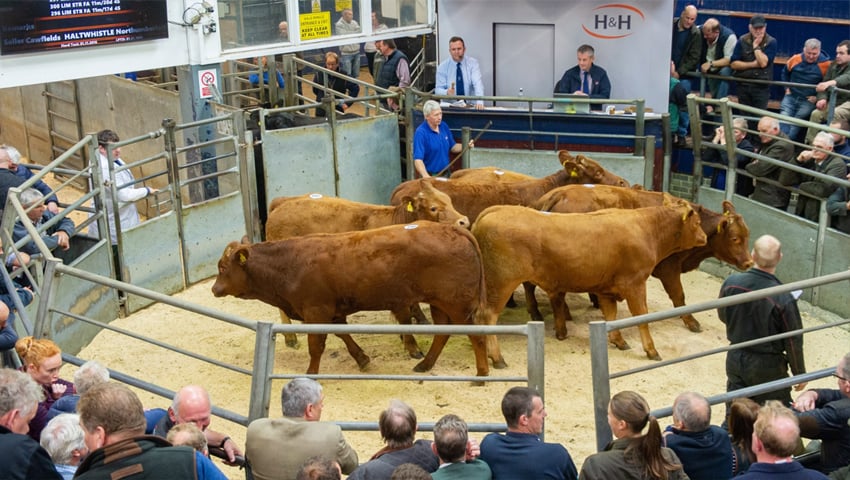The value to the farmer of a competitive marketplace is starkly reflected in the latest throughput and turnover figures released this week by the Livestock Auctioneers’ Association (LAA).
In what has been termed ‘the good news story’ for the producer, against a backdrop of uncertainty and widespread lack of farmer confidence, increases in values recorded against all livestock categories sold through the livestock markets of England and Wales, underpin the importance of providing a level-playing field and competitive trade for those marketing their stock.
The LAA says the rising values reflect the unique strength of the live auction ring in responding to market forces, specifically a tightening of supply, amid the decreasing national herd and flock, and its role in safeguarding a competitive marketplace.
A total of 10.7 million cattle, sheep and pigs, including 6.7 million slaughter livestock and 4 million store and breeding stock, were sold through the live auction rings of England and Wales in 2024, at a combined turnover nearing £2.5 billion (£2,455,617,000).
This represents an increase of over £220 million on the year.
Prices in line with market forces
The livestock auction market provides industry-wide transparency and confidence that prices are in line with market forces, particularly reflected through the beef sector in 2024 and into this year.
Chris Dodds, Executive Secretary of the LAA, said, “What we are clearly seeing with the latest figures, is that the live auction ring really supports that producer confidence, ensuring competition remains in the beef supply chain, driving those values as supply tightens.
“While livestock values started to increase in the latter part of 2024, they have continued to rise beyond expectations into 2025, with record prices for prime cattle, cull cows, store cattle and calves recorded across the marts of England and Wales in the early part of this year.”
For example, Darlington Farmers Auction Mart saw the clean cattle trade break the £5 per kg barrier for the first time, in the last week of March 2025, with 22 heifers over 500ppk, with a further 31 over that £5 barrier, topping at 526ppk, the following week.
Store cattle trade at Welshpool has also continued to go up a gear since the turn of the year, hitting previously unseen levels, with 12-month-old Charolais cattle achieving £2000 and beyond. The market has seen store cattle up to £2840, with commercial cattle selling to 558ppk, offering great encouragement for the future.
Likewise, the LAA Market Prices platform shows 2025 cull cow prices for 12 April have increased by 53 per cent on the same time in 2024, while prime cattle have averaged an increase of 43 per cent on 2024 prices.
The 2024 livestock values show the start of these significant increases across prime cattle (+£105/head), cull cows (+£61/head) and store cattle (+£71/head), reflecting how the competitive marketplace is driving those values against the tightening domestic supply.
Prime sheep values also saw a rise, up £25 per head at an average of £137 per head. While there was a slight, 1.2 per cent decrease in throughput numbers through the livestock markets in 2024, when compared to the 8 per cent national reduction in sheep slaughter numbers, it is clear the attraction of the competitive marketplace is drawing producers back to the live auction ring.
With supply expected to remain tight, and prices to hold accordingly, that theme is set to continue.
Reassurance for dairy farmers
Dairy farmers have also been coming back to the live sales ring in numbers, and the LAA believes there are some correlations with the introduction in 2024 of the new Fair Dealings Obligation (Milk) regulations (FDOM24), aiming to make producer and processor contracts fairer and more transparent across the dairy sector.
Dodds said, “As an industry which has suffered from a lack of transparency, with pricing structures dictated and controlled by processors and retailers, the live auction ring offers dairy farmers the reassurance they need in the provision of a fair, transparent and competitive marketplace to sell their livestock.”
An additional 5,500 dairy cows came through the live auction ring in 2024, at an average of £1,435 per head, up £125 per head on the year.
Best in British
Elsewhere, a significant rise in the number of store and breeding sheep sold through the live auction ring was seen, in line with increasing values.
Dodds said, “Purchasers are favouring the live auction ring for the quality and availability of livestock, showcasing the best in British.
“As a result, producers are reaping the rewards, as is reflected in that increase in store and breeding sheep prices, despite the reducing national flock.”
The 2024 throughput and turnover figures show the live auction ring to be delivering for farmers, at a time when confidence and mental health issues have been dominating the headlines, on the back of budget and support cutting announcements, and increasing industry challenges.
Dodds said, “The liveweight trade is the good news story for the producer in these challenging times.
“Our markets are working tirelessly to achieve the best possible price for the livestock sold, while also providing that highly valued social hub, for farmers and their families, that makes our contribution to the wider rural economy and community so crucial.”
